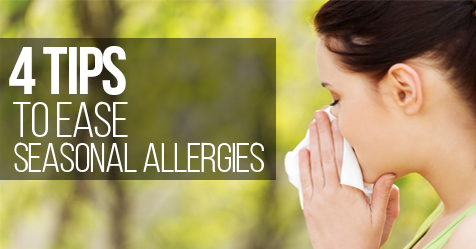Four Tips to Ease Seasonal Allergies This Year

It finally seems like the Spring season is here! It is time to retire those snow shovels and snowblowers to the shed.
Flowers are bluming, birds are singing, and allergy sufferers are beginning to feel the effects of seasonal allergies.
Spring is blur of stuffy, running noses, sneezing and misery for many of us. Fortunately there is ample information available on ways to cut down on suffering.
The first and most simple way to combat irritants is to open or close the windows in your room, depending on what your allergic to. If you suffer from dust and mold allergies: keep them open, as much as possible. If you have pollen allergies, close them. This is especially important in the morning hours. The cold air sinks overnight and that can concentrate pollen levels near the ground in the morning hours. When the sun comes up, the atmosphere starts to mix things around more.
Pollen can also follow people and pets inside your home. Take off your shoes before coming inside and if you’ve been outside for a long time, consider changing your clothes and/or shower upon your return. If your pets spend a lot of time outside, wipe them with a damp towel before they come inside.
The next step toward avoiding exposure and alleviating symptoms is to keep your HVAC system maintained and change filters regularly.
HVAC systems can harbor many different pollutants, including pollen, mold and dander. Changing filters regularly with ones that are constructed to filter out even more particulate matter – like pollen and dust – is recommended. The frequency with which you do this depends on your system and your home. Do you have pets? Is your house well insulated? Some people change filters every month and others do it every three months.
It’s also wise to keep the air inside your home moving. This time of year you’ll want to keep the fan on your HVAC system on so the air can continue to be filtered. Experts agree you should have your HVAC system inspected every year and cleaned every three to five years. Burkholder’s HVAC can help keep your symptoms at bay. Contact us to schedule a maintenance on your system.
Here’s a list of four easy ways to control a pollen allergy from the Allergy and Asthma Technology LLC:
- Use a HEPA air purifier to capture the pollens in your home. HEPA air purifiers do an excellent job of capturing the pollens in your home and office. They will capture over 99.9 percent of the pollens that pass through them. Since they typically clean the air in a room 4-10 times per hour, you can be confident that they will keep the air in the room virtually pollen-free. It is not necessary to put an air cleaner in every room. Putting an air cleaner in your bedroom, family room, and office will allow most people to be in a pollen-free room the vast majority of the time they spend indoors.
- Install a quality disposable filter in your central air system. To keep pollens out of the rooms which do not have an air purifier, it helps to use a quality disposable filter in the central air system. Airborne pollens will eventually circulate through the central air system and can be captured using a highly efficient disposable filter. Because all central air systems require a disposable filter, it makes sense to choose one that is effective at capturing pollens and other allergens.
- Use a filter on your window screens and window air conditioner. Pollen often enters the home through open windows. While the best method of keeping pollen out is keeping the window shut, there are effective filters that capture pollens so they will not enter through an open window. Also, people who use a window air conditioner should use a filter specially designed to prevent the air conditioner from sucking the pollens into the home.
- Wear a face mask when outdoors. When you must be outside for an extended period during the season when pollen counts are high, or if you must be in an area of very high pollen levels, you can wear a mask that will keep you from breathing in pollens. A variety of masks are available, from simple lightweight masks to masks with HEPA filters.
